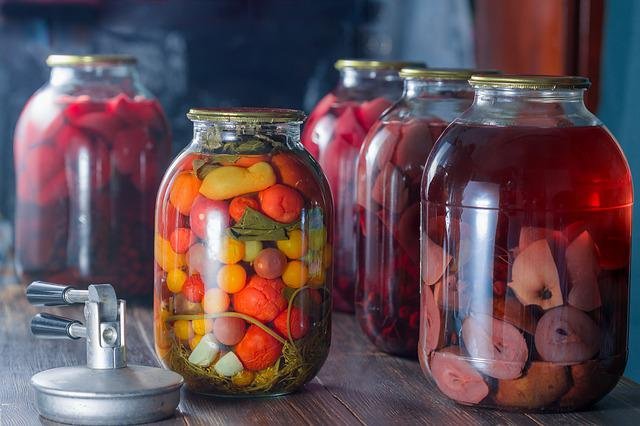How Lacto-Fermentation Safely Preserves Food.
Cucumbers are transformed into the traditional deli dill pickles by the lacto-fermentation procedure.
It’s the process that makes sauerkraut out of cabbage, and it’s also how traditional Korean kimchi is made. It is one of the oldest methods of food preservation, having been used by humans for countless years.
Probiotics found in lacto-fermented foods have been linked to centenarian lifespan in cultures that consume a lot of fermented foods and can boast of a high proportion of people living to be at least 100 years old.
Whether you are aware of it or not, you have been consuming fermented foods for years. Fermented foods include soy sauce, vinegar, bread, tea, and miso in addition to the obvious ones like wine and beer.
They also include a variety of foods that are often referred to as “pickles,” which is confusing since pickles are also the name for preserves made with vinegar.
The metamorphosis brought about by live organisms that produce a fermented pickle, however, is quite different from the technique used to manufacture vinegar-brined pickles.
It is intriguing that fermentation, particularly Lacto-fermentation, has seen the biggest increase in popularity among food preservation techniques in recent years. There are several fermentation classes and enthusiast internet communities.
Why are so many people eager to consume and produce foods that depend on a thriving population of bacteria in an age where antibacterial wipes are readily available to sanitize anything and everything before you touch it?
Why are antibiotics routinely given to meat animals as a preventive measure rather than an emergency treatment?
Perhaps yogurt, a fermented meal, is to blame. I considered whether to put yogurt in this chapter rather than the one on dairy, but ultimately decided against it. People are aware that yogurt is supposedly healthy. Even if they are unsure of what precisely it implies, most people are aware that the label claim “containing live acidophilus cultures” denotes something particularly beneficial.
They may have been paying exorbitant sums for “probiotics” at the health food shop in an effort to maintain a healthy digestive and immune system, lessen inflammation, hasten the healing of yeast infections, and maybe even stave against certain types of cancer.
Then they learned that fermenting food at home was a delightful and affordable way to get the same beneficial microorganisms. Live cultures and probiotics are nice terms to describe the bacterial frenzy that produces Lacto fermented food in these anti-microbe times.
How to Safely Preserve Food Through Lacto-Fermentation
Put some finely chopped veggies in a jar (which doesn’t need to be sterilized). They are encased in a lightly salted brine. After a few days or weeks of letting them sit out at room temperature, move them to a chilly but not freezing location. That essentially sums up the lacto-fermentation process.
That method seems entirely illogical and terrifying to many individuals.
The jars don’t need to be sterilized? And you keep the food out at room temperature for days rather than just an hour or two? And you don’t sterilize the food by canning it with high heat? Here is how it works and why it is secure.
Some of the many diverse bacteria that inhabit the earth with us may be harmful or even fatal to humans (hello, botulism toxin). Others, however, not only do not damage us but actively improve our health. According to recent studies, the helpful bacteria that are always present inside of us and are in close contact with our bodies, we couldn’t survive without them.
At its most fundamental level, Lacto-fermentation functions because it produces habitats with extreme pH levels. Several Lactobacillus species that can withstand salt are essential to the process. These helpful bacteria may be found on the outside of fruits and vegetables. In the majority of Lacto-fermentation recipes, the fresh ingredients are submerged in an alkaline (salty) brine.
In addition to encouraging Lactobacillus to begin fermenting the food, the salty brine also starts the process of removing unwanted bacteria that are not as salt resistant as Lactobacillus. The Lactobacillus turns the food’s lactose and other carbohydrates into lactic acid during the fermentation process.
The procedure is known as Lacto-fermentation for this reason. The lactic acid, which also gives Lacto-fermented foods their distinctively tangy flavor, generates a low-pH (acidic) environment where pathogenic bacteria cannot thrive. In essence, the probiotic bacteria colonize the area and render it uninhabitable for other bacteria.
How to Prepare Throughout Fermentation
You’ll see some bubbles on the brine the food is immersed in after a day or two at room temperature. The liquid will go from being clear to becoming somewhat cloudier (but it shouldn’t be entirely so).
A lovely mild, tangy fragrance will emerge (think pickles).
When these modifications indicate that fermentation has begun, you will move your ferment to a location that is cooler than room temperature, such as your refrigerator. The cooler temperature will still cause fermentation to occur, albeit at a somewhat slower rate.
As a result, your fermented foods retain their texture for a longer period of time than they would if they were allowed to continue swiftly fermenting at warm temperatures. This is crucial when the culinary temperatures include crispness.
This is crucial when the food’s culinary flavor calls for crispness, as it should with sauerkraut or fermented radishes, for instance. But it also implies that even in a refrigerator or a cold cellar, the sour flavor of your ferments will intensify with time.
Make small batches and aim to consume them within a few weeks if you find that you like the fresher taste of a ferment. You should wait up to several months before eating if you like a stronger flavor.
HOW TO USE YOGURT TO GET A WHEY STARTER CULTURE
A yellowish, semi-clear liquid is produced as a byproduct when plain yogurt is strained to create Greek yogurt or yogurt cheese (labneh; both are covered in the Dairy chapter). Whey is that fluid, and it contains a lot of live Lactobacillus probiotic bacteria.
Concerning starter cultures and salt-free fermentation
Although it is not necessary, adding a starting culture helps hasten the fermentation process. If you want to use no salt at all, it might also aid in ensuring good fermentation.
Food may be Lacto-fermented without the use of salt during the first stage. Giving the beneficial bacteria a head start by providing a starting culture is one approach to do this.
Remember that even if you don’t use any salt, you may not require a starting culture since fresh food already contains a lot of probiotic Lactobacillus bacteria. However, the additional probiotics given by a starting culture will increase the likelihood of a successful fermentation if salt is omitted.
Simply said, a starting culture is any liquid or food that already has a ton of beneficial Lactobacillus bacteria. You may create your own starter by either generating whey from yogurt or by storing a little amount of the liquid from a prior ferment.
Simply add some of your starting cultures to your next Lacto-fermentation project to utilize it. For every pint of water or brine, I use around a tablespoon of starting culture.
I’ve successfully fermented a couple of things without the use of salt or a starting culture, just simple filtered water. Some veggies function better with only filtered water, without starting culture.
This approach works better with certain veggies than others. Celery and the ribs (leafstalks) of chard are two that regularly ferment nicely in ordinary filtered water.
Temperature affects Lacto-fermentation even more than it does with brines that have salt added to them. When the room temperature exceeds 85°F, salt-free ferments usually start to go bad.
WHY NOT JUST USE PLUMBING WATER?
The majority of municipal water is chlorinated, and this chlorine is added expressly to combat bacterial growth. It works so well that it may eliminate the probiotic Lactobacillus bacteria that your dish depends on to ferment.
Tips for Lacto-Fermentation Success
• You need more salt in your first brine in hotter environments. In warm conditions, the food may become worse before the helpful bacteria can create a healthy ferment. This is one of the reasons why ferments are often created using cold-season crops like cabbage and root vegetables since it is simpler to ferment meals in chilly temperatures.
In warmer weather, salt-free ferments may be particularly challenging. It’s a good idea to salt the brine a little bit more if you want to create crisp fermented pickles during the hottest weeks of summer.
• Choose fruits and vegetables that are in exceptional shape. Your fermented cucumbers won’t have the crunch you want if they were limp to begin with.
• Recall to use filtered or non-chlorinated water at all times.
• Be ready to do some little maintenance once you begin consuming food that has been Lacto-fermented from one of your jars or crocks. It is a good idea to move the remaining ingredients to a smaller jar or container if a container has two-thirds or fewer of its Lacto-fermented components.
Fermented food has a tendency to pull up out of the liquid that is preserving it and discolor unattractively when it is resting in a container with a lot of air space above it.
• For your ferments, use glass, ceramic, or stainless-steel containers. In addition to imparting an unpleasant taste to the food, certain plastics have the potential to contaminate it with dangerous substances.
• If you want a milder flavor, consume ferments while they are still young; if you prefer a more pucker-inducing level of sourness, let them mature for a few months. The food will remain unharmed for at least a year, although even the most crunchy fermented fruits and vegetables start to soften after around six months.
• Place ferments that you want to consume within a few weeks on the refrigerator’s door’s rather warm shelves. Store the ferment on the top shelf of the refrigerator’s main body, which is the coldest spot, if you want it to preserve its nice texture, last for months, and not become extremely sour-tasting.
• After you’ve finished the food it was used to preserve, save the brine that’s left behind. Sprinkle it over lentil or bean soups, or use it in salad dressings. A little amount of brine from an earlier ferment might be used as a starting culture to jump-start your subsequent one.
It is a bad idea to can Lacto-fermented foods in a boiling water bath or pressure canner. It’s not that you couldn’t; it would be completely safe and result in a product that is more similar to canned sauerkraut from the store (albeit that was likely manufactured using a process that relied on vinegar rather than traditional fermentation).
What’s incorrect with that? All of the beneficial probiotic bacteria in your fermented food will be destroyed by the heat of the canning procedure. It’ll still be palatable. It could even still have some flavor to it.
However, you would have negated one of the main advantages of consuming fermented foods, namely their health advantages.
Utilizing lacto-fermented ingredients in prepared foods
Try to add healthy probiotics to recipes after the heat has been turned off since excessive heat will kill some or all of the healthy bacteria in your ferments. For instance, green bean soup made with Lacto-fermentation is a common meal in Provence. Then, over high heat, potatoes and a little amount of garlic are added to the chicken or vegetable stock.
Green beans are added just after the potatoes have finished cooking and the saucepan has been taken off the heat. Although they are not cooked, the fermented green beans warm up rapidly in the soup and preserve some of their probiotic health benefits.
some of the probiotic health advantages.
If you want to use fermented veggies in a hot meal other than soup, cut them a little bit finer than normal so they may be heated through without being cooked. Fortunately, Lacto-fermented veggies don’t need as much cooking time to become soft as unfermented vegetables.
Several northern European nations serve sauerkraut with sausage, so if you have a strong hankering for it, go for it. However, be aware that although it may taste delicious when served hot, the uncooked form does not have the same nutritional benefits.
More Recipes for Lacto-Fermentation
Since they are the most convenient for many people nowadays, these recipes are in single-jar or small-batch sizes. But by all means, go ahead and work in larger bunches. Just bear in mind that you will need some kind of weight to prevent the components from floating up out of the brine when fermenting your recipe in a crock or other wide-mouth vessel.
For this reason, some specialist fermenting crocks came with fitted weights, but you can construct something that works just as well by placing a plate on top of the ingredients that is small enough to fit within the crock but big enough to cover most of the food.
By placing a closed water jar on top of the plate, you may add weight to it. You may also use a brick or stone as a weight, provided you sanitized them beforehand (they will come into touch with the brine and the fermenting food).
I confess to utilizing that technique in the past. I’ve heard instructions that suggest using a plastic bag filled with salt brine as a weight. Instead of utilizing normal water, salt brine is used in fermentation since it won’t be diluted if the bag leaks.
This method works well as a weight to keep items buried in liquid. But I no longer advise it since an increasing number of individuals (including myself) are attempting to cut down on using plastic.
Generally Useful Gear For Canning And Preservation.




